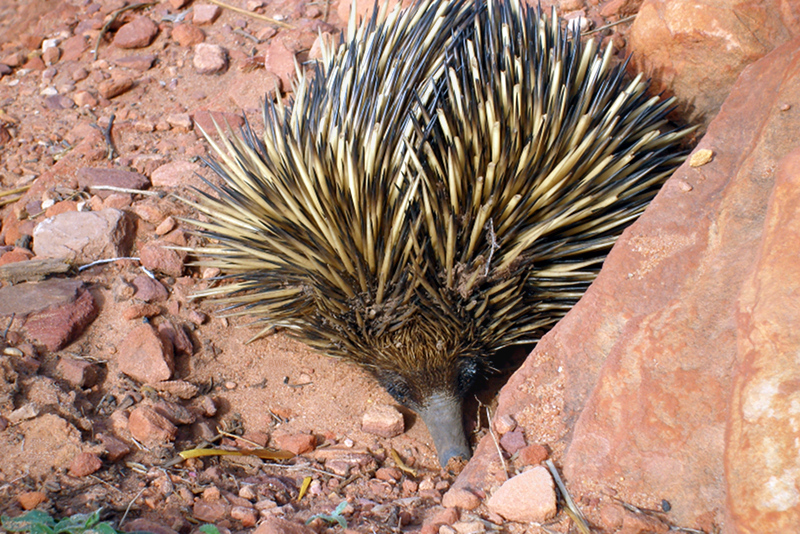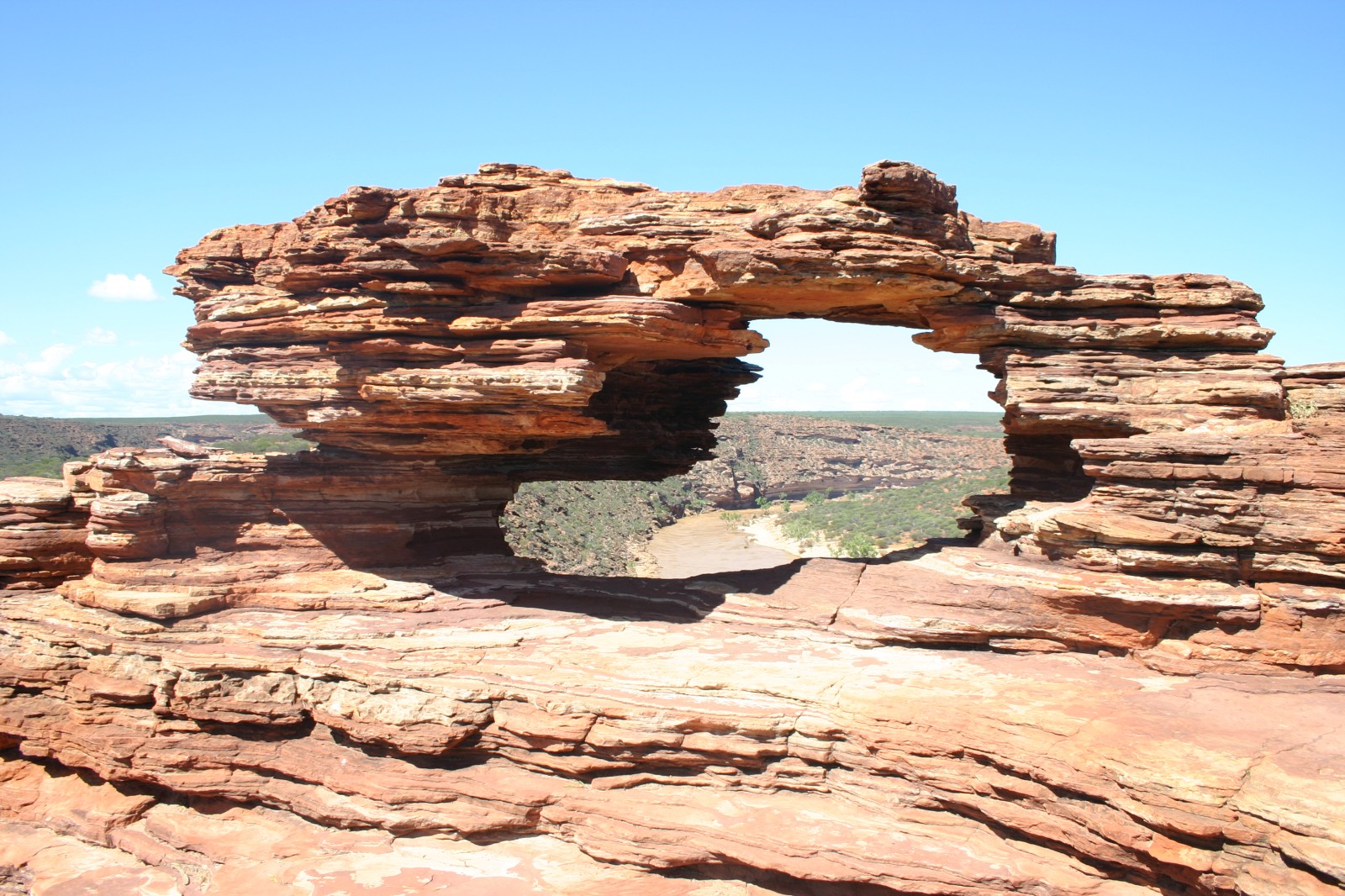Kalbarri National Park on:
[Wikipedia]
[Google]
[Amazon]
Kalbarri National Park is located north of
 Kalbarri National Park preserves the inland desert regions of red and white striped
Kalbarri National Park preserves the inland desert regions of red and white striped
 The Kalbarri area is known for its diversity and extent of wildflowers. More than 800 species of wildflowers bloom from late winter through early summer with peak times in August and September. Twenty-one plant species are found only in the coastal cliff tops and gorge country predominantly in the National Park. One of the best known local plants is the Kalbarri catspaw, a small yellow or red plant that is usually seen on recently burnt country from August to September. Several orchids can only be seen in and near the park, including the Kalbarri
The Kalbarri area is known for its diversity and extent of wildflowers. More than 800 species of wildflowers bloom from late winter through early summer with peak times in August and September. Twenty-one plant species are found only in the coastal cliff tops and gorge country predominantly in the National Park. One of the best known local plants is the Kalbarri catspaw, a small yellow or red plant that is usually seen on recently burnt country from August to September. Several orchids can only be seen in and near the park, including the Kalbarri
 The park area has observation records for about 200 different animal species in the interior of the park along the Murchison River. More than 400 species have been recorded near the coast and around the town of Kalbarri. The threatened
The park area has observation records for about 200 different animal species in the interior of the park along the Murchison River. More than 400 species have been recorded near the coast and around the town of Kalbarri. The threatened

 * Red Bluff
* Mushroom Rock
* Rainbow Valley
* Pot Alley
* Eagle Gorge
* Shellhouse and Grandstand
* Island Rock
* Natural Bridge
Inland part, along the Murchison River Gorge:
* Red Bluff
* Mushroom Rock
* Rainbow Valley
* Pot Alley
* Eagle Gorge
* Shellhouse and Grandstand
* Island Rock
* Natural Bridge
Inland part, along the Murchison River Gorge:
 * Nature's Window
* The Loop
*
* Nature's Window
* The Loop
*
File:Murchison river gorge 1.jpg, Murchison River gorge
File:A199, Kalbarri National Park, Western Australia, Murchison River thru Nature's Window, 2007.JPG, View through Nature's Window
File:Z Bend.jpg, Z Bend, a sharp meander of the river
File:757 32.-Lachnostachys eriobotrya-3jpg.jpg, '' Lachnostachys eriobotrya''
File:760 21-Quoya oldfieldii-1.jpg, '' Quoya oldfieldii''
File:WA 077b Verticordia monadelpha, Kalbarri National Park, Western Australia (19718187071).jpg, '' Verticordia monadelpha''
File:Xylomelum angustifolium at kalbarri NP closeup.jpg, ''
EveryTrail travel site's guide for Kalbarri
{{authority control National parks of Western Australia Shire of Northampton Protected areas established in 1963 Western Australian places listed on the defunct Register of the National Estate 1963 establishments in Australia Kalbarri, Western Australia
Perth
Perth is the capital and largest city of the Australian state of Western Australia. It is the fourth most populous city in Australia and Oceania, with a population of 2.1 million (80% of the state) living in Greater Perth in 2020. Perth is ...
, in the Mid West region of Western Australia.
The major geographical features of the park include the Murchison River gorge which runs for nearly on the lower reaches of the Murchison River. Spectacular coastal cliffs are located on the coast near the mouth of the Murchison River and the town of Kalbarri.
Geography
 Kalbarri National Park preserves the inland desert regions of red and white striped
Kalbarri National Park preserves the inland desert regions of red and white striped Tumblagooda sandstone
The Tumblagooda Sandstone is a geological formation deposited during the Silurian or Ordovician periods, between four and five hundred million years ago, and is now exposed on the west coast of Australia in river and coastal gorges near the tou ...
east of the town of Kalbarri, particularly the lower reaches of the Murchison River and its gorge, as well as the mouth of the river by Meanarra Hill.
The western edge of the park protects the coastline south of the town which features cliffs more than high. The coastal area contains several wind and water eroded rock formations including a sea stack and a natural bridge
A natural arch, natural bridge, or (less commonly) rock arch is a natural landform where an arch has formed with an opening underneath. Natural arches commonly form where inland cliffs, coastal cliffs, fins or stacks are subject to erosion fr ...
.
Climate
The park is open all year round though temperatures can be extremely high from December through April. The park lies in the northernmost limits of the transition zone between a Mediterranean and a semi-arid climate. Winters are warm with moderate precipitation. Summers are hot and dry with temperatures that frequently exceed in the inland part of the park. Inland areas can often be more than 10 °C (18 °F) higher than along the coast and in town. Monthly precipitation levels are low with most rain falling from May through August. Heavy rainfalls may cause the roads to the gorge to be closed.Flora
 The Kalbarri area is known for its diversity and extent of wildflowers. More than 800 species of wildflowers bloom from late winter through early summer with peak times in August and September. Twenty-one plant species are found only in the coastal cliff tops and gorge country predominantly in the National Park. One of the best known local plants is the Kalbarri catspaw, a small yellow or red plant that is usually seen on recently burnt country from August to September. Several orchids can only be seen in and near the park, including the Kalbarri
The Kalbarri area is known for its diversity and extent of wildflowers. More than 800 species of wildflowers bloom from late winter through early summer with peak times in August and September. Twenty-one plant species are found only in the coastal cliff tops and gorge country predominantly in the National Park. One of the best known local plants is the Kalbarri catspaw, a small yellow or red plant that is usually seen on recently burnt country from August to September. Several orchids can only be seen in and near the park, including the Kalbarri spider orchid Spider orchid typically refers to the orchid genus '' Caladenia'' as a whole.
It may also mean one of the following:
* Several '' Corybas'' species, including
** '' Corybas macranthus''
** '' Corybas trilobus''
* '' Dendrobium tetragonum'' ( Commo ...
and the Murchison hammer orchid.
The small-petalled Beyeria or short-petalled Beyeria, once thought to be extinct, was re-discovered in the park in 1994. The population in the park is one of only three known populations.
Fauna
tammar wallaby
The tammar wallaby (''Notamacropus eugenii''), also known as the dama wallaby or darma wallaby, is a small macropod native to South and Western Australia. Though its geographical range has been severely reduced since European colonisation, the ...
was observed previously in the area but not lately.
Approximately 150 bird species have been observed including the emu
The emu () (''Dromaius novaehollandiae'') is the second-tallest living bird after its ratite relative the ostrich. It is endemic to Australia where it is the largest native bird and the only extant member of the genus ''Dromaius''. The em ...
(''Dromaius novaehollandiae''), osprey
The osprey (''Pandion haliaetus''), , also called sea hawk, river hawk, and fish hawk, is a diurnal, fish-eating bird of prey with a cosmopolitan range. It is a large raptor reaching more than in length and across the wings. It is brown o ...
(''Pandion haliaetus''), wedge-tailed eagle
The wedge-tailed eagle (''Aquila audax'') is the largest bird of prey in the continent of Australia. It is also found in southern New Guinea to the north and is distributed as far south as the state of Tasmania. Adults of this species have lo ...
(''Aquila audax'') and Australian pelican
The Australian pelican (''Pelecanus conspicillatus'') is a large waterbird in the family Pelecanidae, widespread on the inland and coastal waters of Australia and New Guinea, also in Fiji, parts of Indonesia and as a vagrant in New Zealand. I ...
(''Pelecanus conspicillatus''). Some of the recorded mammal species in the interior include the western grey kangaroo
The western grey kangaroo (''Macropus fuliginosus''), also referred to as a western grey giant kangaroo, black-faced kangaroo, mallee kangaroo, sooty kangaroo and (when referring to the Kangaroo Island subspecies) Kangaroo Island grey kangaroo, is ...
(''Macropus fuliginosus''), short-beaked echidna (''Tachyglossus aculeatus'') and spinifex hopping mouse (''Notomys alexis''). The only observed bat in the park is the Finlayson's cave bat (''Vespadelus finlaysoni''). The recorded reptile species include the thorny devil (''Moloch horridus''), western bearded dragon (''Pogona minor'') and central netted dragon (''Ctenophorus nuchalis''). The only observed amphibian is Günther's toadlet (''Pseudophryne guentheri''). About 30 different arthropod
Arthropods (, (gen. ποδός)) are invertebrate animals with an exoskeleton, a segmented body, and paired jointed appendages. Arthropods form the phylum Arthropoda. They are distinguished by their jointed limbs and cuticle made of chitin, o ...
s have been recorded including a dragonfly called the Pilbara tiger (''Ictinogomphus dobsoni'') and the savanna black tree ant (''Tetraponera punctulata'').
Activities
The most popular activities are sightseeing, boating, fishing, picnicking and bushwalking. Other activities include abseiling in the gorge and horseback riding, as well as scuba diving, snorkelling, surfing and swimming in the Indian Ocean at Red Bluff Beach and the small beach at Pot Alley. From Kalbarri there are scenic cruises along the Murchison River and flights over Kalbarri National Park. Construction of the two Kalbarri Skywalk platforms are now completed and offer expansive views of the Murchison River Gorge and Kalbarri National Park.
Facilities
There are no campsites or other accommodations and no water available within the park boundaries. All overnight visitors must use the facilities in the town unless they are on a multi-day bushwalk or boat tour.Features
Coastal part, starting from the town of Kalbarri and moving south: * Red Bluff
* Mushroom Rock
* Rainbow Valley
* Pot Alley
* Eagle Gorge
* Shellhouse and Grandstand
* Island Rock
* Natural Bridge
Inland part, along the Murchison River Gorge:
* Red Bluff
* Mushroom Rock
* Rainbow Valley
* Pot Alley
* Eagle Gorge
* Shellhouse and Grandstand
* Island Rock
* Natural Bridge
Inland part, along the Murchison River Gorge:
 * Nature's Window
* The Loop
*
* Nature's Window
* The Loop
* Z Bend
The Z Bend lookout is a popular tourist lookout on the Murchison River Gorge in Western Australia. It is located at ,Gazetteer of Australia (1996). Belconnen, ACT: Australian Surveying and Land Information Group. about east of Kalbarri, in t ...
* Hawks Head
* Ross Graham Lookout
Galleries
Xylomelum angustifolium
''Xylomelum angustifolium'', the sandplain woody pear, is a tree species in the family Proteaceae
The Proteaceae form a family of flowering plants predominantly distributed in the Southern Hemisphere. The family comprises 83 genera with ...
''
See also
* Protected areas of Western AustraliaReferences
External links
EveryTrail travel site's guide for Kalbarri
{{authority control National parks of Western Australia Shire of Northampton Protected areas established in 1963 Western Australian places listed on the defunct Register of the National Estate 1963 establishments in Australia Kalbarri, Western Australia